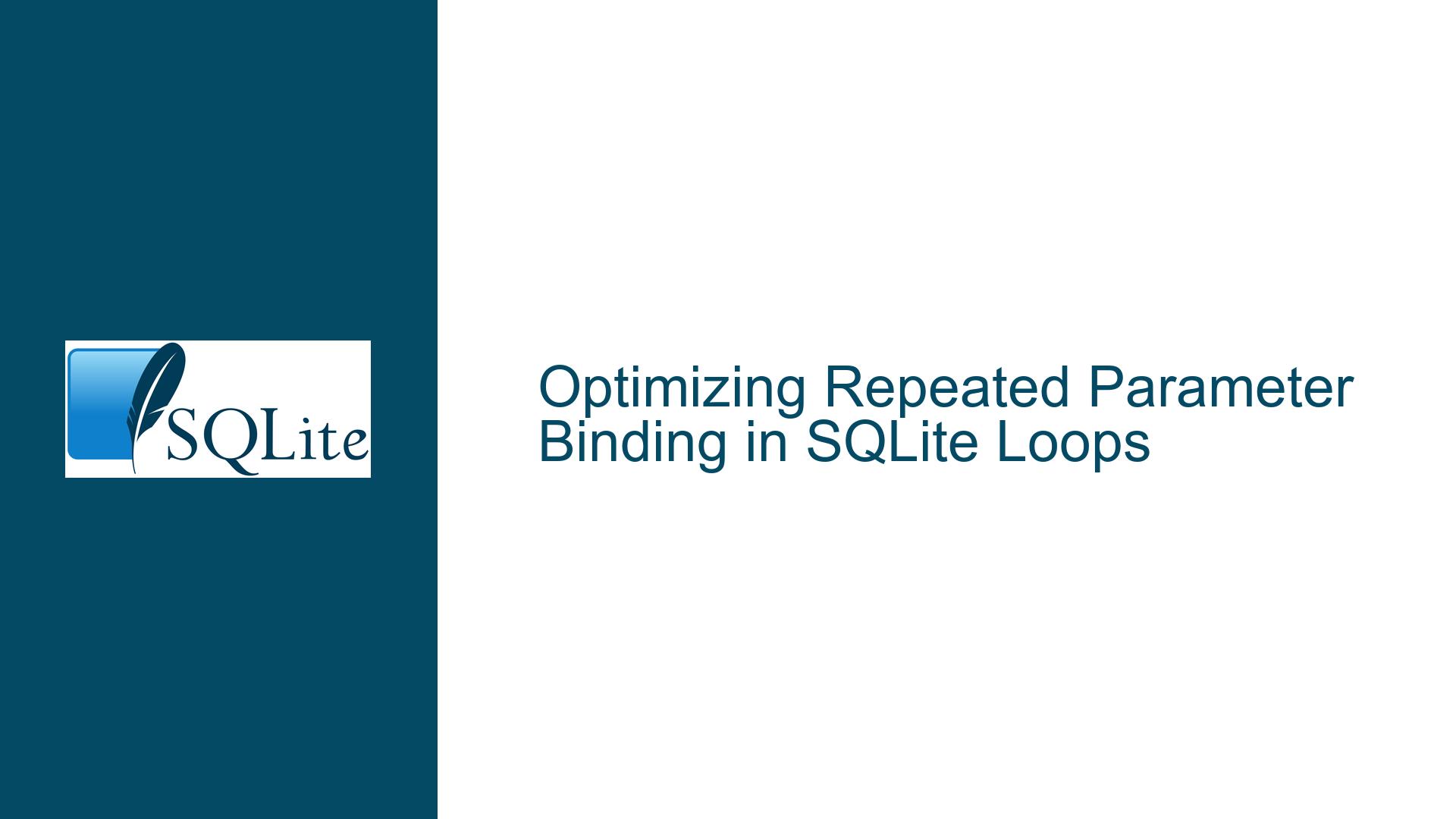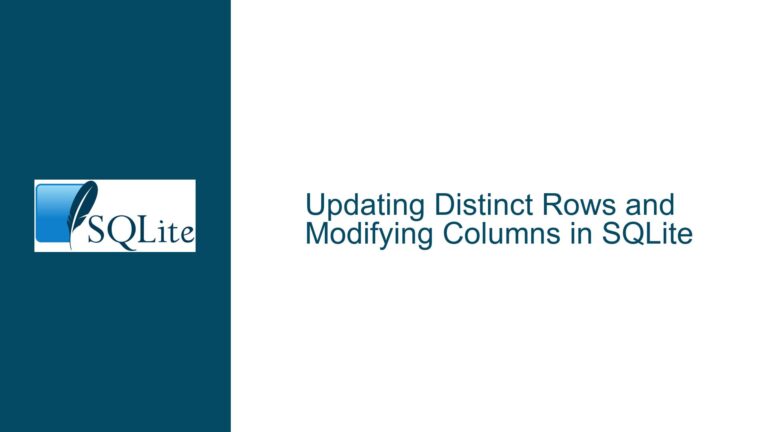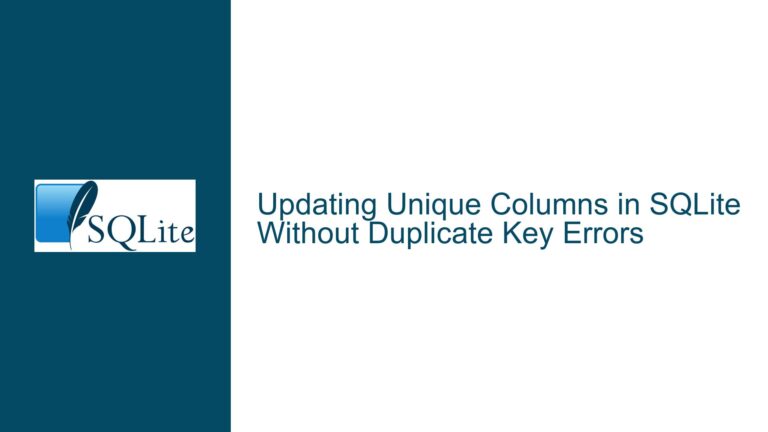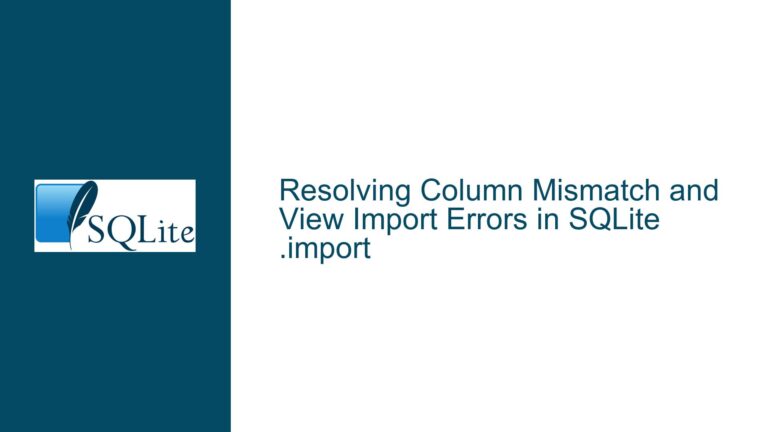Optimizing Repeated Parameter Binding in SQLite Loops
Understanding the Challenge of Repeated Parameter Binding in Loops
When working with SQLite in applications that require bulk insertion, updates, or replacements of records, developers often encounter a recurring pattern: preparing a statement, binding parameters in a loop, executing the statement, and resetting it for the next iteration. A common pain point arises from the need to repeatedly call sqlite3_bind_XXX functions for each parameter during every loop iteration. This process can become computationally expensive, especially when dealing with large datasets or high-frequency transactions.
The core issue here revolves around the lifecycle of prepared statements and how SQLite handles parameter binding. SQLite uses value-based binding, where the bound value is copied into the prepared statement at the time of binding. This design ensures data integrity and isolation between the application’s memory space and SQLite’s internal operations. However, it introduces overhead when the same statement is reused with different parameter values in a loop. Developers seeking optimization naturally gravitate toward the idea of reference-based binding, where parameters are bound to memory addresses (pointers) that hold the values. This approach would theoretically eliminate the need for repeated binding calls, as the statement would automatically read the latest value from the referenced memory location during execution.
The discussion highlights several critical questions:
- Does SQLite already support reference-based binding?
- What are the technical barriers to implementing such a feature?
- Are there existing workarounds or best practices to mitigate the overhead?
This guide explores these questions in depth, providing actionable insights for developers facing this challenge.
Technical Constraints and Design Philosophy of SQLite’s Binding Mechanism
To understand why reference-based binding is not natively supported in SQLite, we must examine its architecture, threading model, and safety guarantees. SQLite prioritizes simplicity, reliability, and deterministic behavior over micro-optimizations that could compromise these attributes. Below are the key factors that make reference-based binding inherently problematic within SQLite’s design framework:
1. Data Consistency During Statement Execution
SQLite’s bytecode engine (VDBE) operates under the assumption that bound parameter values remain constant throughout the execution of a prepared statement. If parameters were bound by reference, concurrent modifications to the referenced memory (e.g., by other threads or asynchronous callbacks) could lead to inconsistent or corrupted data during statement execution. For example, a SELECT statement that reads a bound parameter multiple times might see different values if the underlying data changes mid-execution, violating the atomicity of the operation.
2. Thread Safety and Memory Management
SQLite’s threading model allows prepared statements to be used across threads, provided that proper synchronization is enforced by the application. Reference-based binding would require SQLite to manage external memory pointers, introducing complexities such as:
- Lifetime management: Ensuring referenced memory remains valid throughout the statement’s lifecycle.
- Thread synchronization: Preventing data races when multiple threads access or modify the referenced data.
- Pointer aliasing: Handling cases where multiple parameters reference the same memory location, leading to unintended side effects.
These challenges conflict with SQLite’s goal of being a lightweight, self-contained library with minimal external dependencies.
3. Performance Trade-offs
While reference-based binding might reduce the number of API calls in a loop, it does not necessarily improve performance. SQLite’s internal copying of bound values is highly optimized, often involving nothing more than a memory copy or reference counting (for blobs/text with SQLITE_STATIC or SQLITE_TRANSIENT). Introducing pointer dereferencing during statement execution could increase latency due to:
- Additional pointer indirection during value retrieval.
- Cache inefficiencies caused by scattered memory accesses.
- Overhead from runtime checks to validate pointer integrity.
4. Existing Alternatives
SQLite provides mechanisms to achieve similar outcomes without reference-based binding:
- Virtual Tables: Custom virtual table implementations can expose external data sources (e.g., in-memory arrays or files) as SQL-readable tables, enabling bulk
INSERT ... SELECToperations. - Batch Binding Patterns: Application-layer abstractions (e.g., templated C++ functions or macro systems) can automate parameter binding, reducing boilerplate code.
- SQLite’s Bulk Insertion Tools: The
sqlite3_execfunction withBEGIN TRANSACTION/COMMITblocks can optimize bulk inserts by minimizing transaction overhead.
These alternatives align with SQLite’s philosophy of keeping the core simple while allowing extensibility through well-defined interfaces.
Strategies for Efficient Parameter Binding in Loops
While reference-based binding is not feasible within SQLite’s current design, developers can employ several strategies to optimize parameter binding in loops. These approaches balance performance, maintainability, and adherence to SQLite’s operational constraints.
1. Leverage SQLITE_STATIC for Large Blobs and Text
For applications dealing with large binary objects (BLOBs) or text values, the SQLITE_STATIC flag can eliminate unnecessary data copying. When binding a BLOB or text parameter with SQLITE_STATIC, SQLite assumes the application will maintain the underlying memory’s validity until the statement is finalized or rebound. This allows the application to reuse the same memory buffer across multiple executions without copying data.
Example:
// Assume 'data_buffer' is updated in each loop iteration
sqlite3_stmt *stmt;
sqlite3_prepare_v2(db, "INSERT INTO images(data) VALUES(?)", -1, &stmt, NULL);
while (/* ... */) {
// Update data_buffer with new image data
generate_image_data(data_buffer, buffer_size);
// Bind using SQLITE_STATIC to avoid copying
sqlite3_bind_blob(stmt, 1, data_buffer, buffer_size, SQLITE_STATIC);
sqlite3_step(stmt);
sqlite3_reset(stmt);
}
sqlite3_finalize(stmt);
Caveats:
- The application must ensure
data_bufferremains unmodified duringsqlite3_step(). - For dynamically allocated buffers, use
SQLITE_TRANSIENTto let SQLite manage copies.
2. Use Virtual Tables for External Data Integration
Virtual tables allow SQLite to interact with external data sources as if they were native tables. By implementing a virtual table that reads from an in-memory array or application-managed structure, developers can perform bulk inserts or updates using standard SQL syntax.
Steps to Implement a Virtual Table:
- Define the Virtual Table Module: Implement the
xCreate,xConnect,xBestIndex,xOpen,xClose,xFilter,xNext, andxColumnmethods. - Expose Data Through Cursors: Use application-managed data structures (e.g., arrays) to feed data to the virtual table during queries.
- Execute Bulk Operations: Use
INSERT INTO ... SELECT FROM virtual_tableto transfer data efficiently.
Example (Using the array Extension):
SQLite’s array extension (requires loading) provides a virtual table interface for in-memory arrays:
-- Load the array extension (if not built-in)
.load ./array
-- Create a virtual table backed by an application array
CREATE VIRTUAL TABLE temp.external_data USING array(
"id INTEGER",
"value TEXT"
);
-- Insert data into the actual table using a SELECT
INSERT INTO target_table(id, value)
SELECT id, value FROM temp.external_data;
3. Application-Layer Binding Abstraction
Encapsulate the binding logic in a reusable function or class to reduce redundancy. This approach is particularly effective in object-oriented languages like C++ or Python.
C++ Example with Templated Binding:
template<typename T>
void bind_parameter(sqlite3_stmt* stmt, int index, const T& value);
// Specialization for integers
template<>
void bind_parameter<int>(sqlite3_stmt* stmt, int index, const int& value) {
sqlite3_bind_int(stmt, index, value);
}
// Specialization for std::string
template<>
void bind_parameter<std::string>(sqlite3_stmt* stmt, int index, const std::string& value) {
sqlite3_bind_text(stmt, index, value.c_str(), value.size(), SQLITE_TRANSIENT);
}
// Usage in a loop
struct Record {
int id;
std::string name;
};
sqlite3_stmt* stmt;
sqlite3_prepare_v2(db, "INSERT INTO records(id, name) VALUES(?, ?)", -1, &stmt, NULL);
for (const auto& record : records) {
bind_parameter(stmt, 1, record.id);
bind_parameter(stmt, 2, record.name);
sqlite3_step(stmt);
sqlite3_reset(stmt);
}
sqlite3_finalize(stmt);
4. Optimize Transaction Management
Minimize transaction overhead by wrapping bulk operations in explicit transactions. This reduces disk I/O and lock contention.
Example:
sqlite3_exec(db, "BEGIN TRANSACTION", NULL, NULL, NULL);
sqlite3_stmt* stmt;
sqlite3_prepare_v2(db, "INSERT INTO data(value) VALUES(?)", -1, &stmt, NULL);
for (int i = 0; i < 100000; i++) {
sqlite3_bind_int(stmt, 1, i);
sqlite3_step(stmt);
sqlite3_reset(stmt);
}
sqlite3_finalize(stmt);
sqlite3_exec(db, "COMMIT", NULL, NULL, NULL);
5. Prepared Statement Reuse and Caching
Reuse prepared statements across loop iterations to avoid recompilation. SQLite automatically caches prepared statements for the duration of a database connection, but explicit management can improve performance in long-running applications.
Example:
// Global or context-level statement cache
std::unordered_map<std::string, sqlite3_stmt*> statement_cache;
sqlite3_stmt* get_cached_statement(sqlite3* db, const std::string& sql) {
auto it = statement_cache.find(sql);
if (it != statement_cache.end()) {
return it->second;
}
sqlite3_stmt* stmt;
sqlite3_prepare_v2(db, sql.c_str(), -1, &stmt, NULL);
statement_cache[sql] = stmt;
return stmt;
}
// Usage
sqlite3_stmt* stmt = get_cached_statement(db, "INSERT INTO data(value) VALUES(?)");
6. Evaluate Alternative Data Transfer Methods
For extreme performance requirements, consider bypassing SQLite’s binding API entirely:
- CSV Import: Use
.importcommand in the SQLite CLI for bulk data loading. - Temporary Files: Write data to a temporary file and use
INSERT ... SELECTwithreadfile()(if available). - In-Memory Databases: For transient data, use an in-memory database (
:memory:) as a staging area.
Conclusion: Balancing Efficiency and Safety
The absence of reference-based binding in SQLite is a deliberate design choice rooted in the library’s commitment to data integrity and operational simplicity. While the idea of binding parameters by reference is appealing for optimizing loops, the potential risks—data races, memory corruption, and unpredictable behavior—outweigh the marginal performance gains. Developers are encouraged to leverage SQLite’s existing features, such as virtual tables, transaction batching, and binding flags like SQLITE_STATIC, to achieve efficient data handling. By combining these techniques with application-layer abstractions, it is possible to maintain both performance and reliability in even the most demanding use cases.






